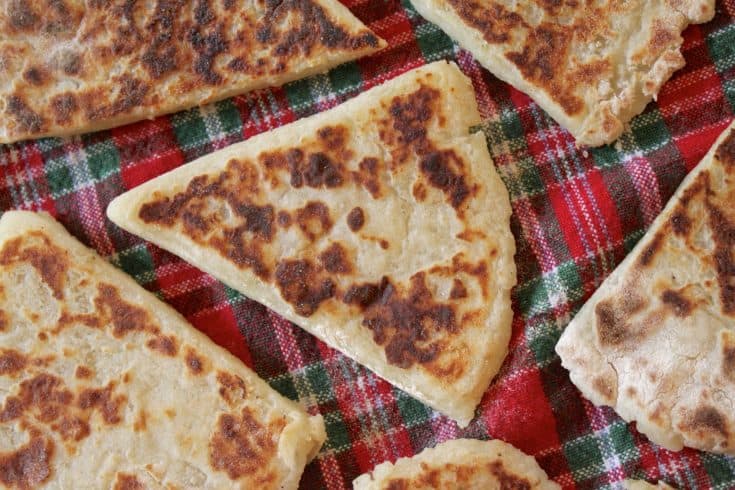A typical potato/”tattie” scone (pronounced like “gone” not like “tone” in America. Think “colonel”) is made with mashed potato and butter (no milk is used), with salt to taste. Plain flour is added to make it into a dough which is then rolled out and put on a grill skillet to cook and are flat. They are traditionally served hot, and cold potato scones are often reheated by toasting or frying. Potato scones are made with a small proportion of flour to a large proportion of potatoes: one traditional recipe calls for two ounces of flour and half an ounce of butter to a pound of potatoes.
Another version of the scone is made in circles about 6 inches across and then cut into quarters. They are about an inch thick, more than what is usually considered a scone. They are served as part of the “full Scottish breakfast” (and England, Wales and Ulster have their own variations) with fried eggs, square sausage, black pudding, bacon (from a township in Scotland, Ayrshire… and shipped worldwide for its beloved taste), baked beans and grilled or fried tomato with mushrooms.Yee-umm. They are often eaten in a roll with “just” the fried egg, sausage and bacon. One of these and you can feel your arterties clogging. Two, is a heart attack. A fun-fact: Scotland’s diet is renowned for its high volume of fried fats. Include Mars bars and even pizza.
Potato scones originated as a Scottish quick bread. Originally made with oats and griddle-baked, today’s version is more often made with flour and baked in the oven. Some claim it comes from the Dutch word ‘schoonbrot’, which means beautiful bread, while others argue it comes from Stone of Destiny, where the Kings of Scotland were crowned (I believe the latter). According to Webster’s Dictionary, scones originated in Scotland in the early 1500s.
In all honesty, when considering its association with the “full breakfast”, perhaps it should only be allowed to be eaten with jam and a cuppa.
For a quick and easy (it really is) recipe: https://www.allrecipes.com/recipe/241419/potato-scones/
https://en.wikipedia.org/wiki/Full_breakfast http://www.foodreference.com/html/a-scone-history.html


Great post Fraser!